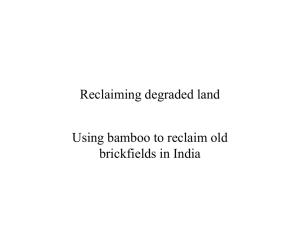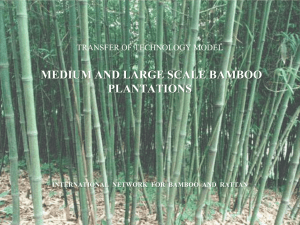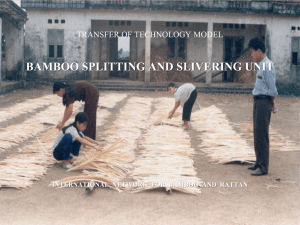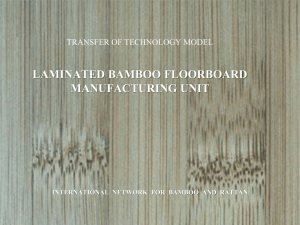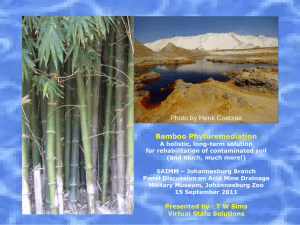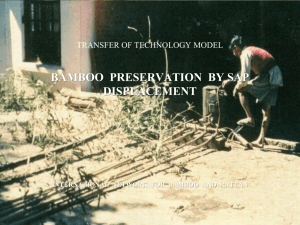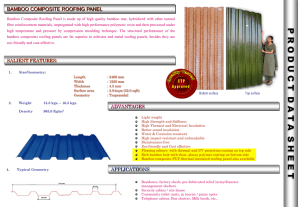File
advertisement
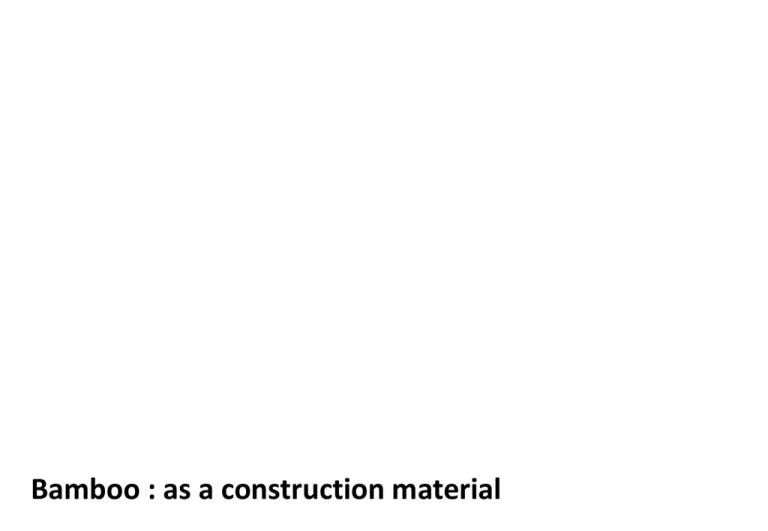
Bamboo : as a construction material Anatomy of Bamboo • Bamboo is a perennial evergreen that is part of the grass family (a very tall and woody grass that is). • Similar to grass, bamboo is characterized by a jointed stem called a culm. Typically the culms are hollow but some species of bamboo have solid culms. • Each culm segment begins and ends with a solid joint called a node. Nodes are characterized by a swelling encircling the ends of the culm segments. • The segments between the nodes are called internodes. • From the nodes grow leaves and branches. Similar to the culms, the branches are also segmented with nodes and internodes. Stem - A slender or elongated structure that supports a plant Types of Bamboo Sympodial (grows in clumps) Monopodial (grows singly) Properties Tensile strength: The fibers of the bamboo run axial. In the outer zone are highly elastic vascular bundle, that have a high tensile strength. The tensile strength of these fibers is higher than that of steel, but its not possible to construct connections that can transfer these tensile strengths. Shrinking: Bamboo shrinks more than wood when it loses water. Fire resistance: The fire resistance is very good because of the high content of silicate acid. Filled up with water, it can stand a temperature of 400° C while the water cooks inside. Elasticity: The enormous elasticity of bamboo makes it to efficient building material for earth-quakeendangered areas. Another advantage of bamboo is its low weight. It can be transported and worked easily, the use of cranes is mostly unnecessary. Development of bamboo structure in India Bamboo building techniques as it exists is mostly traditional in nature gained over years. As bamboo by nature is a highly perishable material, its use in construction has always been considered temporary and not surprisingly bamboo is replaced almost every year in most of the rural constructions. Main characteristic features, which make bamboo as a potential building material, are • its High tensile/bending strength and comparable to that of mild steel and wood • High strength to weight ratio and high specific load bearing capacity • Requires less energy for production compared to material like steel, plastics, aluminum etc. • Physical-mechanical properties of bamboo which grows to maturity in 4 to 5 years compares favorably with that of hardwood which requires 40 to 50 years to attain maturity. Above all bamboo is renewable raw material resource from agro-forestry and if properly treated and industrially processed, components made by bamboo can have a reasonable life of 30 to 40 years. Though natural durability of bamboo varies according to species and the types of treatments, varied uses and applications in building construction have established bamboo as an environment-friendly, energyefficient and cost-effective construction material. The working of bamboo Bamboo can be worked with the simplest tools which must be especially sharp because of the highly silicified outer zone. Tool wear is considerably high. Recommendable methods: Splitting: very easy as long as you work along the cane axis. The cane is split in halves and quarters and the driven apart by a wedge. It can also be split with a knife frame into four or eight segments. Cutting with a machete-type or knife used for cutting. Sawing By means of splitting you get halved canes, strips and battens. To get planks, all the nodes are smashed and the wall of the pole is split over its entire length and forced open until the wall of the pole lies flat. Up to the age of 18 months, the canes can be peeled. The strips can be used as ties or be woven to make strings and ropes. Shaping: Bamboo which grows in a box gets a square shape. So it can be better used for connections. Bending: Freshly cut, bamboo can be bent and will keep this shape after drying. When heated above 150° C, bamboo keeps its shape after it goes cold. Scopes Bamboo as a building material • Bamboo is one of the oldest materials used for the construction of houses and other structures. • Its strength, flexibility and versatility make it a suitable material for addressing every housing component when treated and used properly. Bamboo is relatively cheap, easy to work with and readily available in most warm climate countries. It is estimated that more than one billion people in the world live in bamboo house and in Bangladesh alone more than 70% houses are made up of bamboo. • Bamboo can be a potential building material in the most of the developing countries where it grows. It grows in the most of the African and Asian countries where the affordable. Scope - Bamboo houses Bamboo houses are without exception skeletal buildings having raised floors with main posts which are anchored in the ground. Typical bamboo elements are canes, halved canes, laths, beading, bamboo boards and rope ties. This way of construction offers the following advantages: pre-fabrication, simple assembly, simple replacement of structural parts; the bamboo elements can be easily dismantled and reused Scope - Bamboo Houses – Types Of Foundation Scope - Bamboo Houses – Types Of Walls Scope - Roofing The simplest roof covering is formed by bamboo shingles which are as long as the rafters. Lancet shingles Scope - Footbridges and bridges Footbridge without surface Tied battens hold the poles together and act as a load distributor so that the load on a single pole is transferred to its neighbour. The ends of the poles are pinned to the ground. Footbridge with surface of woven batten The layer of poles has differing spacings. The woven battens provide rigidity and distribute the load. Piles serve as intermediate supports and also as posts for the handrail. Scope - Scaffolding Because of the favorable relationship between load-bearing capacity and weight, bamboo can be used for the construction. Detail – joinery – Bamboo cuts these are the most common cuts to use when making bamboo joints: one ear two ear beveled flute mouth Fish mouth Detail – joinery – Joining horizontal with vertical elements Joint with one or two ears. Is used to join bamboo rafters, logs or lumber. Detail – joinery – Use of dowels and anchors in bamboo joinery 1. Joining bamboo with dowels and lashing. The peg should be placed in the column parallel to the rafter. 2. Fish mouth joint with pegs. 3. Bamboo joint with wooden anchor. Is also used inverted. Peg - A wooden pin pushed or driven into a surface Dowel - A fastener that is inserted into holes in two adjacent pieces and holds them together Detail – joinery – Joining and fixation of bamboo Cross joint with dowel. Lateral joint with dowel. Corner joint
